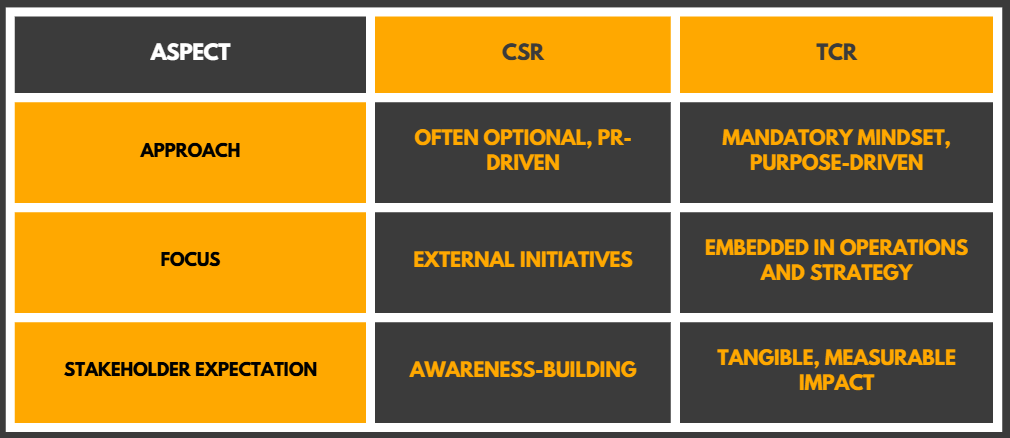Why Total Corporate Responsibility Is the Future of Sustainable Business
Sustainability is no longer a side project or a checkbox for modern businesses; it has become the core of long-term growth and resilience. Many companies are familiar with Corporate Social Responsibility (CSR), ESG initiatives, and social impact programs, but a deeper, more holistic approach is now emerging: Total Corporate Responsibility (TCR).
So, what is Total Corporate Responsibility? In simple terms, TCR means embedding responsibility into every decision, department, and product. It’s about creating a culture where ethical, social, and environmental considerations are inseparable from business strategy. Unlike traditional CSR, which often focuses on isolated initiatives or philanthropy, TCR ensures that corporate sustainability and accountability are fully integrated into daily operations, from supply chains to product design to employee engagement.
Why does this matter? Because in today’s world, consumers, investors, and employees expect businesses to go beyond reporting or compliance. They want companies to act responsibly at every level. For instance, brands that embrace TCR often see enhanced reputation, stronger customer loyalty, and improved financial performance. A McKinsey study found that companies leading in ESG and responsible business practices outperformed peers, with higher stock returns over five years, demonstrating that responsibility and profitability can go hand in hand.
TCR also transforms how organizations view Corporate Citizenship. Rather than isolated community programs, it positions the company as a positive force in society, embedding social and environmental impact into the very way business is done. This shift isn’t just strategic, it’s also a mindset change, asking leaders: “How can every action we take create lasting value for our stakeholders and the planet?”
Did You Know? Nearly 90% of millennials say they prefer to work for companies that have a positive impact on society, highlighting the growing expectation for TCR in attracting and retaining top talent. Could your organization afford to ignore this shift?
Also read: Corporate Volunteer Programs Driving Purposeful Impact Around the World
What Is Total Corporate Responsibility?
Total Corporate Responsibility (TCR) is a holistic approach to business where social impact, environmental sustainability, ethics, and governance are woven into every layer of operations. Imagine CSR, ESG, and corporate purpose working together seamlessly, rather than as separate initiatives.
You might ask, “How is TCR different from traditional CSR?” While CSR often focuses on community projects, philanthropy, or one-off sustainability campaigns, TCR makes responsibility a core business strategy. It’s about embedding purpose into every decision, product, and process, turning social and environmental impact into a measurable, integral part of business growth.
Key Aspects of Total Corporate Responsibility
- Integration of CSR, ESG, DEI, and sustainability goals: Every decision, from supply chain choices to marketing campaigns, is filtered through the lens of social and environmental responsibility.
- Data-driven accountability: Companies track, measure, and report their impact transparently. For example, Patagonia and Unilever publish detailed sustainability reports to show exactly how their operations affect the environment and communities.
- Stakeholder trust: According to the 2024 Edelman Trust Barometer, 73% of consumers expect companies to take an active role in addressing social issues. This shows that responsible business isn’t optional, it’s expected.
If your company’s decisions today affect communities, employees, and the planet for decades, how would that change your approach to business?
TCR isn’t just about “doing good”; it’s about making purpose, ethics, and sustainability central to a company’s DNA, creating long-term value for all stakeholders, not just shareholders. By adopting TCR, organizations can transform Corporate Citizenship from a series of projects into a guiding philosophy that touches every aspect of their operations.
How Is Total Corporate Responsibility Different from Traditional CSR?
You might wonder, “Isn’t CSR enough?” Traditional Corporate Social Responsibility (CSR) often focuses on external initiatives like donations, volunteering programs, or community projects. While these efforts are valuable, they can sometimes be isolated or PR-driven rather than shaping core business decisions.
Total Corporate Responsibility (TCR) takes responsibility inside the organization. It influences how companies produce, hire, communicate, and grow, ensuring that purpose and sustainability are embedded in operations, strategy, and culture.

Some Brands that Got it Right
- Patagonia ensures environmental responsibility across its entire supply chain, from sourcing raw materials to product end-of-life, not just in marketing campaigns.
- Unilever ties sustainability metrics to executive KPIs, making corporate sustainability a company-wide priority rather than a side project.
- Salesforce integrates social impact into product development and employee programs, demonstrating how Total Corporate Social Responsibility can influence innovation and culture.
According to Deloitte’s 2024 Global Human Capital Trends, companies with integrated responsibility strategies are 2.5 times more likely to attract and retain top talent, showing that employees care deeply about authentic corporate citizenship.
Modern consumers, employees, and investors expect action, not announcements. TCR ensures businesses don’t just talk about doing good; they live it through every decision and process, creating measurable impact for all stakeholders.
What Is the Role of Corporate Sustainability in Total Corporate Responsibility?
Corporate sustainability is the backbone of total corporate responsibility. It ensures that business growth doesn’t come at the expense of people or the planet, balancing profit, purpose, and social impact equally.
Sustainability goes far beyond carbon footprints or energy savings; it influences every decision a company makes: from sourcing raw materials and designing products to production, logistics, and even marketing. Companies like IKEA and Microsoft tie sustainability goals directly to executive KPIs, making accountability and tangible results an integral part of their strategy.
Did You Know?
According to the World Economic Forum 2023, companies with strong sustainability practices see up to 20% higher operational efficiency, showing that responsible business isn’t just ethical, it’s smart business.
How Sustainability Reporting Fits into Total Corporate Responsibility
Sustainability reporting is more than a compliance exercise; it’s a strategic tool that translates what ESG is and other metrics into actionable business insights. By measuring and reporting on environmental, social, and governance outcomes, organizations can:
- Track progress against corporate sustainability targets.
- Adjust strategies for greater impact.
- Communicate results clearly to stakeholders, building corporate citizenship and trust.
In the context of total corporate social responsibility, reporting ensures that every action is transparent, measurable, and accountable, turning abstract ESG goals into meaningful, real-world change.
Think: if every business decision you made could positively impact society and the environment, how would that transform your company culture?
What Is ESG, and How Does It Fit into Total Corporate Responsibility?
ESG (Environmental, Social, and Governance) is a framework used to measure a company’s impact on the environment, society, and governance practices. Many people assume that ESG is the same as responsibility, but it’s actually a measurement tool, not the philosophy itself. In the context of total corporate responsibility, ESG provides concrete benchmarks that help businesses make informed decisions, track performance, and maintain accountability across all operations.
By integrating ESG into TCR, companies can move beyond reporting and embed responsible practices into every function, from product development to hiring to supply chain management.
How Businesses Can Align ESG and TCR Goals
- Set materiality priorities – Identify the environmental, social, and governance issues that matter most to your business and stakeholders.
- Integrate ESG into strategy – Ensure every department uses ESG insights to guide decisions, aligning daily operations with total corporate social responsibility goals.
- Use impact dashboards – Monitor performance in real-time to maintain transparency and enable quick course corrections.
- Report and refine – Leverage ESG metrics to continuously improve TCR initiatives and corporate sustainability outcomes.
A 2023 MSCI study found that companies with integrated ESG and responsibility strategies saw lower operational risks and higher investor confidence, proving that ESG isn’t just a measurement; it’s a tool for long-term business resilience.
By aligning ESG with total corporate responsibility, businesses move from simply measuring impact to actively shaping it. ESG metrics become more than numbers; they guide decisions that enhance corporate citizenship, strengthen stakeholder trust, and drive meaningful corporate sustainability outcomes. When companies treat ESG as a tool rather than a goal, they can ensure that every initiative, policy, and product contributes to a larger purpose: creating long-term value for people, planet, and profit alike.
Also go through: Employee Resource Groups (ERGs) - All You Need to Know in order to boost employee engagement with these innovative virtual volunteering ideas.
From CSR to Total Corporate Responsibility: Real-World Success Stories
Many companies are moving beyond traditional CSR to fully embrace total corporate responsibility, turning isolated initiatives into strategic, purpose-driven practices that touch every part of the business. Here are some standout examples:
Unilever
Unilever treats sustainability not as an obligation but as a core growth strategy. It’s embedded across product innovation, supply chains, and marketing campaigns — driving both measurable impact and business success.
Key initiatives:
- Sustainable Living Brands: Brands like Dove, Lifebuoy, and Hellmann’s that integrate sustainability into their purpose have grown faster than the rest of the portfolio.
- Regenerative agriculture: Over 1 million hectares of farmland are being transitioned to regenerative practices.
- Carbon reduction: Unilever has achieved a 72% cut in operational GHG emissions since 2015 and aims for net-zero by 2039.
- Deforestation-free supply chains: Sourcing transparency for palm oil, soy, paper, and tea ensures environmental and ethical standards.

Through these actions, Unilever demonstrates that purpose-led growth can deliver long-term profitability and trust.
Ben & Jerry’s
Ben & Jerry’s stands out as a pioneer in linking activism and business. Its three-part mission—product, economic, and social—is deeply embedded into everyday operations and decision-making.
What they’re doing:
- Ethical sourcing: Ingredients are Fairtrade-certified, and suppliers are selected based on shared social values.
- Advocacy and activism: Campaigns for racial justice, climate action, and LGBTQ+ rights are core to brand identity.
- Employee and community engagement: Employees participate in activism training and local community impact projects.
This integration of social purpose enhances customer loyalty, shapes policy discourse, and shows that corporate citizenship can be both authentic and profitable.
Salesforce
Salesforce’s approach to responsibility is holistic—rooted in its 1-1-1 philanthropy model, aligning profit with purpose. The model donates 1% of equity, 1% of product, and 1% of employee time to community impact.
Key impact areas:
- Global giving: Over $700 million donated in grants to education, equality, and climate programs.
- Employee engagement: Millions of volunteer hours logged by Salesforce employees worldwide.
- Sustainability leadership: Achieved 100% renewable energy and net-zero residual emissions across operations.
- Equity focus: Ongoing initiatives to close the gender and racial pay gap, and build inclusive leadership pipelines.
By linking CSR directly to its operations, Salesforce proves that total corporate responsibility (TCR) can strengthen both culture and competitive edge.
Infosys (India)
Infosys demonstrates how TCR transcends geography, embedding responsibility into its business DNA. Its ESG Vision 2030 focuses on three pillars — climate action, digital empowerment, and inclusive growth.
Highlights:
- Carbon neutrality: Achieved in 2020, making Infosys one of the first global IT companies to do so.
- Renewable energy commitment: Significant investment in green buildings and solar infrastructure across campuses.
- Education and inclusion: Through Infosys Foundation and Springboard, millions benefit from digital literacy and rural education.
- Community impact: Over 125 million lives positively impacted through health, sanitation, and education programs in India.
Infosys proves that sustainability and profitability can co-exist — delivering innovation-led growth while uplifting communities and protecting the planet.
When CSR Evolves Into TCR:
The journey from CSR to TCR becomes clear when traditional programs transform into long-term strategic levers that shape culture, operations, and purpose:
- Community Programs as a Year-Long, Company-Wide Culture
Community programs are no longer just one-off events or occasional volunteering opportunities—they can evolve into a sustained, company-wide culture that engages employees throughout the year. By integrating community involvement into performance metrics, recognition programs, and internal communications, organizations can make social impact part of the daily work experience.
For example, a company might establish quarterly volunteering initiatives, encourage employee-led social projects, and provide time or resources for staff to participate during work hours. When community engagement is embedded into onboarding, leadership programs, and team-building activities, it becomes a shared value that drives employee motivation, fosters collaboration, and enhances retention. Over time, this consistent engagement builds a culture where doing good in the community is seen as a core part of what the company stands for, rather than an optional extra.
- Philanthropic Giving Aligned with ESG and Sustainability Goals
Strategic philanthropic giving can reinforce a company’s sustainability and ESG objectives, creating measurable social and environmental outcomes. For instance, a company focused on renewable energy could direct grants or employee-led initiatives toward clean energy projects in local communities. Similarly, a business with a commitment to education may fund STEM programs or vocational training aligned with workforce development goals. By aligning giving with broader ESG targets, companies not only contribute to social good but also enhance their credibility with stakeholders and investors, demonstrating that corporate responsibility and business success can advance hand in hand.
- CSR Projects Informing Core Business Decisions
Corporate Social Responsibility (CSR) initiatives can serve as a feedback loop for core business strategies, influencing product development, supply chain choices, and operational improvements. For example:
- A company running a sustainable agriculture program may gain insights into eco-friendly sourcing, which can guide procurement policies and supplier partnerships.
- CSR initiatives focused on local community needs can inspire new products or services tailored to underserved markets, creating both social value and commercial opportunity.
- Employee volunteer programs in customer-facing roles can uncover inefficiencies or unmet needs, feeding directly into operational or service enhancements.
By treating CSR as more than a side project and leveraging the insights it generates, companies embed sustainability and social responsibility into everyday decisions, making it an integral part of business growth rather than an afterthought.
When companies treat CSR initiatives as stepping stones to total corporate responsibility, every program, from volunteering and giving to sustainability projects, evolves into a strategy that delivers lasting value for communities, employees, and the planet. This approach reshapes planning, execution, and impact measurement, ensuring that responsibility is no longer optional but woven into the very fabric of the business.
You can also explore how technology is transforming corporate volunteering worldwide in the blog: Technology in Corporate Volunteering.
How Can Companies Adopt Total Corporate Responsibility? A Step-by-Step Guide
Adopting total corporate responsibility isn’t about checking boxes; it starts with leadership and culture. Companies that succeed embed accountability, empathy, and purpose into every function, making responsibility a core part of how they operate. Here’s a practical roadmap:
1. Define Your Purpose
Every impactful CSR program starts with a clear purpose that aligns business goals with social and environmental outcomes. Companies need to ask: “How can our products, services, and operations create value for people, communities, and the planet?” A strong purpose guides strategic decisions across product development, marketing, and employee engagement.
- Patagonia: The outdoor apparel brand’s mission—“We’re in business to save our home planet”—influences every decision. Patagonia sources recycled and organic materials, runs a repair and resale program to extend product life, and donates 1% of sales to environmental causes. This purpose not only drives environmental impact but also builds strong customer loyalty and brand credibility.
- Unilever: Its Sustainable Living Plan integrates health, hygiene, and environmental sustainability into everyday operations. For example, Unilever’s Lifebuoy soap campaigns focus on hygiene education in communities, while the company reduces water usage and carbon emissions in production. This purpose-driven approach ensures that every product and initiative contributes to both social good and business growth.
2. Engage Stakeholders
CSR is most effective when it involves employees, suppliers, customers, and communities. Engagement ensures initiatives meet real needs and encourages active participation.
- Salesforce: The company’s “Volunteer Time Off” program gives employees dedicated paid hours to volunteer in local communities. Additionally, Salesforce partners with suppliers to promote sustainability practices, ensuring the entire ecosystem participates in responsible business practices.
- Ben & Jerry’s: Beyond selling ice cream, the company actively collaborates with communities on social campaigns. For instance, they work with local organizations to raise awareness and take action on climate change and racial justice issues. By including communities and employees in advocacy, the initiatives are more impactful and authentic.
- Collaborative Feedback: Programs that integrate surveys, advisory boards, and employee-led initiatives ensure continuous input from all stakeholders, creating a culture where CSR becomes a shared responsibility rather than a top-down mandate.
3. Integrate ESG and CSR Metrics into Strategy
Measuring impact turns CSR from a checkbox exercise into a strategic tool that informs business decisions. ESG metrics help track progress, identify areas for improvement, and link social and environmental outcomes to core operational goals.
- Microsoft: The company ties carbon reduction targets to executive incentives. They have committed to becoming carbon negative by 2030, which involves measuring emissions across all operations, investing in renewable energy, and supporting carbon removal projects. Linking these goals to leadership accountability ensures sustainability is embedded in decision-making.
- Nestlé: Uses detailed community impact metrics to guide rural development programs, such as improving access to clean water and supporting smallholder farmers. By analyzing these metrics, Nestlé can refine sourcing strategies and invest in programs that strengthen the supply chain while benefiting local communities.
- Metrics integration ensures CSR initiatives are actionable, measurable, and directly influence business strategy.
4. Communicate Impact Transparently
Transparent communication builds trust with employees, customers, and investors while demonstrating that CSR initiatives are authentic and measurable.
- Unilever: Publishes an annual Sustainable Living Report that details achievements in environmental and social initiatives, such as reducing greenhouse gas emissions, improving livelihoods, and enhancing product sustainability. Importantly, it also highlights areas for improvement, demonstrating accountability.
- IKEA: Shares dashboards and progress reports showing how much renewable material is used in products, energy efficiency improvements in stores, and social programs in local communities. By translating data into stories, IKEA makes sustainability accessible and engaging for both internal and external audiences.
- Transparent reporting motivates employees, attracts conscious consumers, and strengthens investor confidence, proving that CSR is a core business priority rather than marketing fluff.
5. Keep Evolving
CSR is dynamic. To remain impactful, companies must continuously assess, iterate, and innovate initiatives, ensuring relevance amid changing societal and environmental challenges.
- Danone: Moved from one-time charitable donations to long-term initiatives in nutrition, health, and regenerative agriculture. For example, their “One Planet. One Health” framework integrates sustainability into sourcing practices, agriculture, and product innovation.
- Google: Regularly updates its diversity, equity, and sustainability programs based on employee feedback, technology developments, and global priorities. This includes reducing data center emissions, improving renewable energy use, and supporting STEM education programs worldwide.
- Continuous improvement ensures CSR initiatives remain relevant, embedded in strategy, and capable of generating measurable long-term impact.
Companies that embed total corporate responsibility into their core operations don’t just benefit society and the environment; they also see tangible business advantages. For example, a 2023 Harvard Business Review study found that firms with purpose-driven, integrated responsibility strategies experienced up to 18% higher long-term profitability and stronger brand loyalty. This shows that adopting TCR isn’t just the right thing to do, it’s also a smart business strategy that creates lasting value for all stakeholders.
Wrapping It Up: TCR is the future of Sustainable Business
Total Corporate Responsibility is the future of sustainable business because it shifts the focus from isolated initiatives to holistic, purpose-driven operations. In today’s world, businesses are no longer judged solely on profits; consumers, employees, and investors expect companies to create meaningful social and environmental impact while maintaining financial performance. TCR answers that demand by embedding responsibility into every decision, department, and product, turning ethics, sustainability, and governance into core business imperatives.
Companies that adopt TCR don’t just mitigate risks or enhance reputation; they build resilience, trust, and long-term value. By aligning purpose with profit and impact, businesses can innovate more responsibly, attract and retain talent, and strengthen stakeholder relationships. In essence, TCR is not just a strategy; it’s a mindset that transforms organizations into forces for good, proving that responsible business is smart business.
The future belongs to companies that take total responsibility, not only for what they produce, but for the positive change they create in the world.
Explore how companies are transforming communities through impactful and accountable CSR strategies.

Frequently Asked Questions
1. What are the benefits of adopting Total Corporate Responsibility?
Adopting TCR helps companies enhance reputation, build trust with stakeholders, attract and retain talent, and improve long-term financial performance. It also ensures that social, environmental, and governance considerations are embedded in all business operations, leading to sustainable growth.
2. How does TCR impact company culture?
TCR fosters a purpose-driven culture where employees feel their work contributes to meaningful outcomes. It encourages collaboration, accountability, and innovation by aligning individual roles with broader social and environmental goals, creating a more engaged and motivated workforce.
3. Is Total Corporate Responsibility the same as sustainability?
Not exactly. Sustainability focuses primarily on environmental and resource-related practices, while TCR is broader, encompassing social impact, ethics, governance, corporate citizenship, and sustainability. Sustainability is one pillar of TCR, but TCR integrates multiple dimensions into every aspect of business.
4. How does TCR affect investor relations?
Investors increasingly evaluate companies based on ESG performance and responsible business practices. Organizations that adopt TCR often experience higher investor confidence, lower operational risks, and stronger long-term growth potential, making them more attractive to purpose-driven and traditional investors alike.
5. Can Total Corporate Responsibility drive innovation?
Yes. By embedding responsibility into products, services, and processes, companies can identify new opportunities for sustainable solutions. For example, designing eco-friendly products, improving supply chain efficiency, or creating socially inclusive services can give businesses a competitive advantage.
6. What metrics can companies use to measure TCR impact?
Metrics may include ESG scores, carbon footprint reduction, diversity and inclusion statistics, employee engagement levels, community impact metrics, and sustainability reporting indicators. These allow businesses to track progress, identify areas for improvement, and demonstrate accountability.
7. How long does it take to implement Total Corporate Responsibility?
Implementing TCR is an ongoing journey rather than a one-time project. While initial steps like defining purpose and engaging stakeholders can start immediately, full integration across operations, culture, and strategy may take months or even years, depending on the organization’s size and complexity.
8. Is Total Corporate Responsibility relevant for all industries?
Absolutely. Every industry, from manufacturing and technology to finance and retail, can embed responsibility into operations, supply chains, and business strategies. The specific initiatives may vary, but the principles of ethics, sustainability, and stakeholder impact apply universally.
9. How does TCR benefit customers?
Customers increasingly prefer brands that act responsibly. TCR ensures products and services are sustainable, ethical, and socially impactful, enhancing customer trust, loyalty, and satisfaction while aligning with modern consumer expectations.
10. Can technology help in implementing Total Corporate Responsibility?
Yes, technology plays a critical role in tracking ESG metrics, measuring impact, and reporting progress. Tools like impact dashboards, sustainability software, and data analytics platforms help companies integrate TCR into daily operations and decision-making efficiently.
11. Can small businesses adopt Total Corporate Responsibility?
Yes, TCR is not limited to large corporations. Small businesses can implement TCR by making intentional, responsible choices. This can include ethical sourcing, inclusive hiring, transparent communication, and integrating sustainability practices into everyday operations. Even small-scale initiatives can create meaningful impact and set the foundation for a purpose-driven, responsible business culture.
12. Why is TCR important for employees?
TCR creates a purpose-driven work environment where employees can see the positive impact of their work on society and the environment. This fosters engagement, inclusion, and satisfaction, helping companies attract and retain top talent. Employees are more motivated when they feel connected to a larger mission, which strengthens organizational culture and overall performance.
13. What are examples of companies practicing Total Corporate Responsibility?
Several companies have successfully embraced TCR, turning responsibility into a core business strategy. For instance, Unilever integrates sustainability into supply chains, products, and marketing. Patagonia ensures environmental responsibility across sourcing, production, and product lifecycle. Salesforce aligns CSR initiatives with business strategy and employee engagement, while Infosys in India combines education, sustainability, and workforce inclusion into its operations. These examples show how TCR can drive impact and business growth simultaneously.
14. How can a company start implementing TCR?
Companies can begin by defining a clear purpose that aligns business goals with social and environmental outcomes. Engaging stakeholders such as employees, suppliers, and communities is key to building collective impact. Integrating ESG and CSR metrics into strategy ensures that performance is measurable and actionable. Transparent communication through reports, dashboards, or storytelling builds trust and accountability. Finally, TCR requires continuous evolution, regularly refining initiatives to maximize












